Menus
- Retro roadster in comparison test
- Like a pack of wolves under a full moon
- Triumph Bonneville T 100 runs extremely cultivated
- Harley Sportster 883 vibrates like Guzzi V9
- Sitting position on the Moto Guzzi V9 Roamer
- Sitting position on the Harley-Davidson Sportster 883 Iron
- Sitting position on the Triumph Bonneville T 100 Black
- Handling the retro roadster
- Moto Guzzi V9 Roamer with the best braking performance
- Quality of workmanship of the retro bikes
- Conclusion from the test
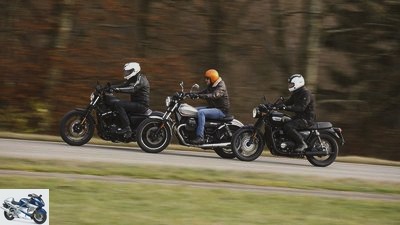
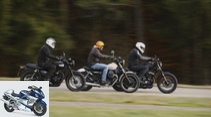
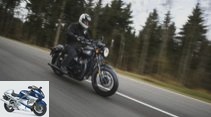
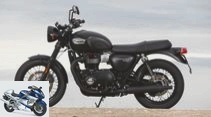
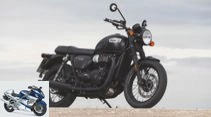
35 photos
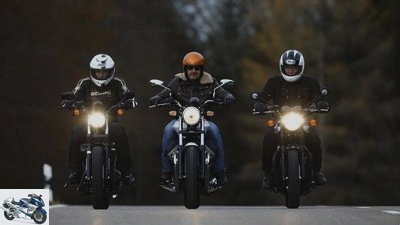
1/35
Photo gallery: Triumph Bonneville T100 Black, Moto Guzzi V9 Roamer and Harley-Davidson Sportster 883 Iron in a comparison test.
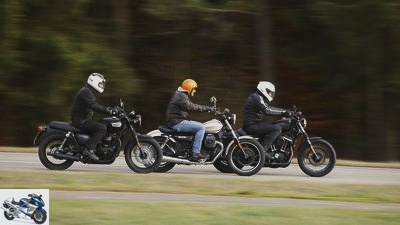
2/35
MOTORRAD has found that the three retro roadsters in this comparison are not seriously interested in being faster than their ancestors. They prefer to invite you to relax and glide.
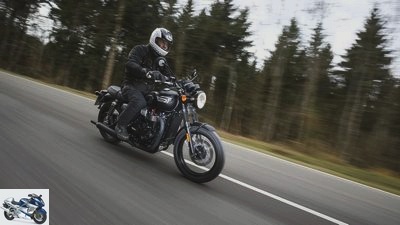
3/35
Triumph Bonneville T100 Black: Only when looking from the front is the discreetly placed water cooler in front of the frame loops noticeable.
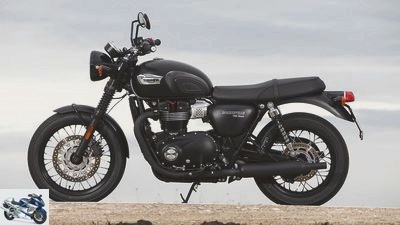
4/35
Triumph Bonneville T100 Black.
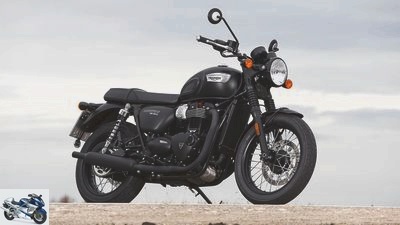
5/35
The model from 1939 is unmistakable in today’s T 100. The great-grandma was considered a fast superbike in her day.
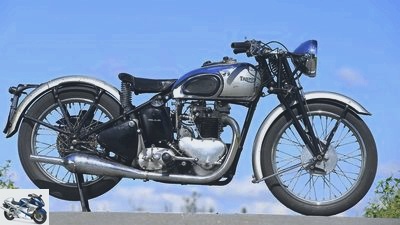
6/35
1939 Triumph T 100.
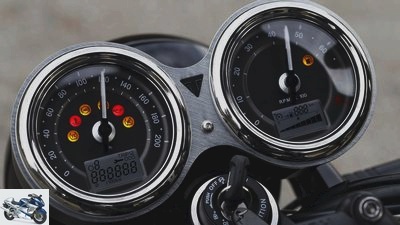
7/35
The Triumph is the only one to offer the classic duo of speedometer and tachometer.

8/35
Again, it is the only one with a lockable fuel filler cap.
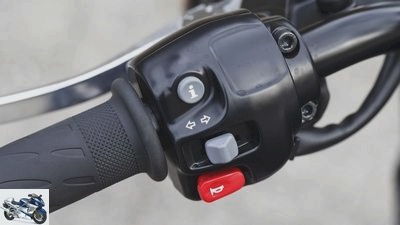
9/35
Not too much at once: the “i-button” calls up various information one after the other.
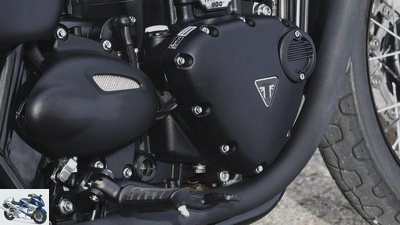
10/35
The rear cover simulates a separate gearbox, but actually hides a number of cables.
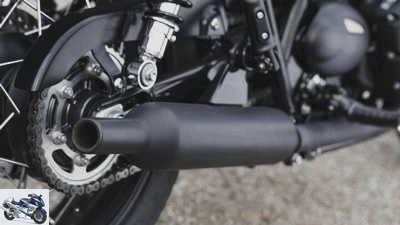
11/35
Triumph Bonneville T100 Black.
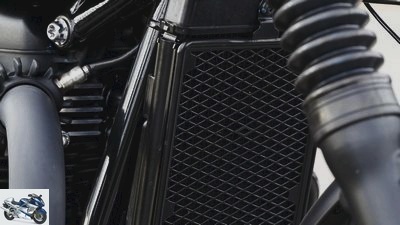
12/35
Triumph Bonneville T100 Black.

13/35
Triumph Bonneville T100 Black.
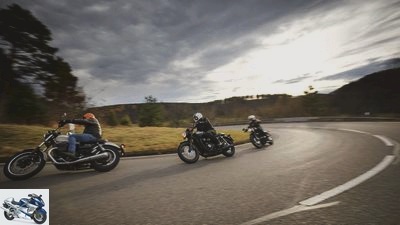
14/35
Triumph Bonneville T100 Black, Moto Guzzi V9 Roamer and Harley-Davidson Sportster 883 Iron in comparison test.
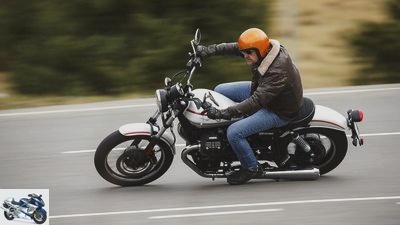
15/35
Moto Guzzi V9 Roamer: As harmonious as the exhausts look from the side, their sloping shape is clumsy.
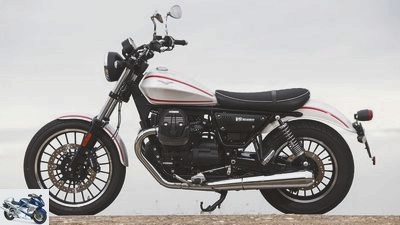
16/35
In 1982 the V 50 C arose from the soft chopper fashion of the time. The Roamer, in English “vagabond”, has a different style, but takes over its technical basis.
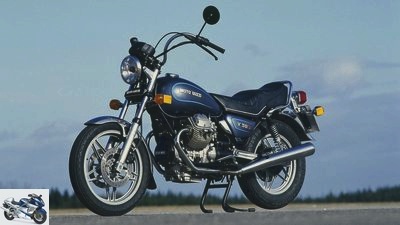
17/35
1982 Moto Guzzi V 50 C..
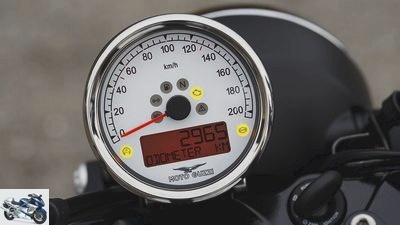
18/35
A puristic display instrument without a rev counter is sufficient for the Guzzi.
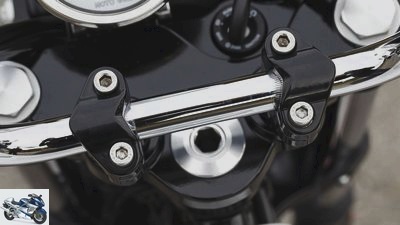
19/35
Critical handlebar clamping: please rework the flat surfaces of the clamping blocks.
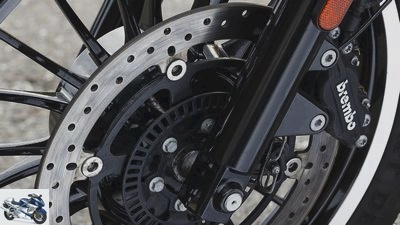
20/35
Single disc and four-piston caliper with a bite: the Roamer brakes best.
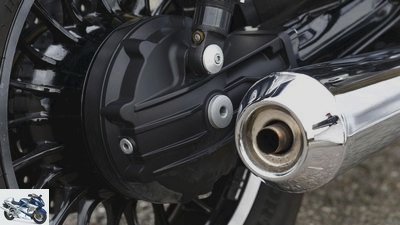
21/35
The Roamer exhausts sound very subdued – the cardan drive does not.
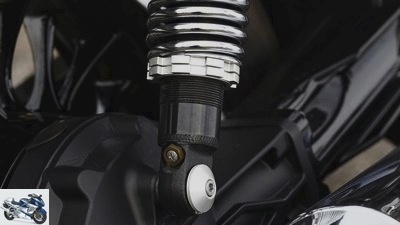
22/35
Moto Guzzi V9 Roamer.
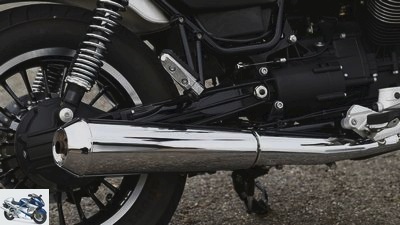
23/35
Moto Guzzi V9 Roamer.
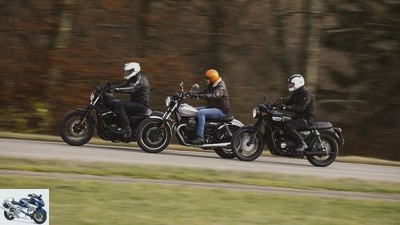
24/35
Triumph Bonneville T100 Black, Moto Guzzi V9 Roamer and Harley-Davidson Sportster 883 Iron in comparison test.

25/35
Harley-Davidson Sportster 883 Iron: The 883 can curve, no question about it. More lean angle would do her good.
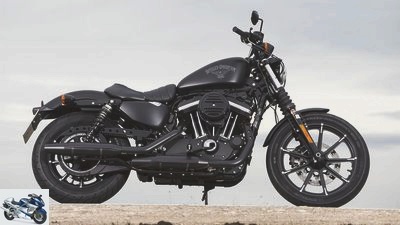
26/35
After the forerunner of the Sportster with side valve K engines was not very successful, Harley-Davidson designed this motorcycle with an OHV engine.
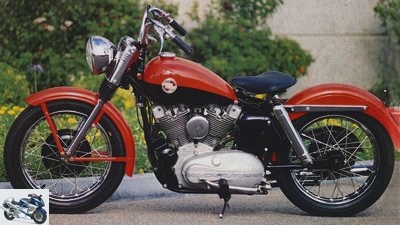
27/35
1957 Harley-Davidson Sportster.
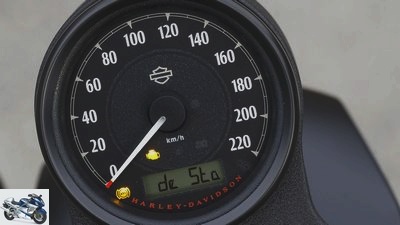
28/35
What you only see while driving: The digital display provides information about gear and engine speed.
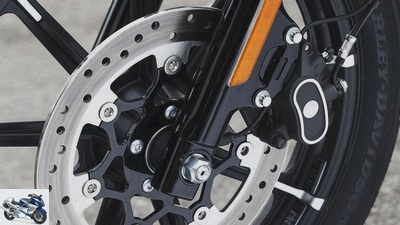
29/35
Hand strength high, effect blunt, dependent on the help of the rear brake.
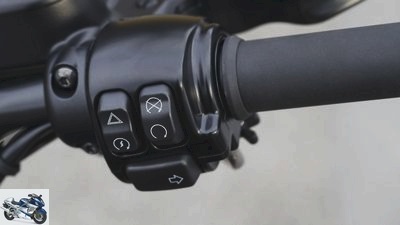
30/35
Turn signal actuation with separate switch, resetting is automatic.
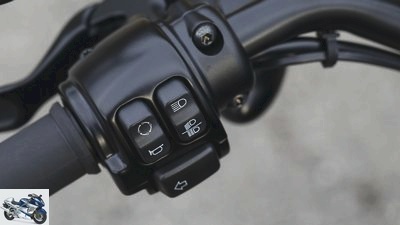
31/35
Harley-Davidson Sportster 883 Iron.
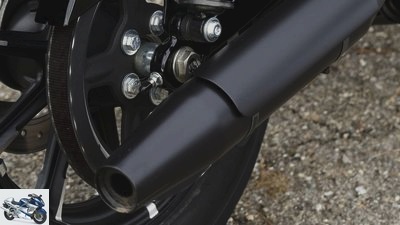
32/35
Harley-Davidson Sportster 883 Iron.
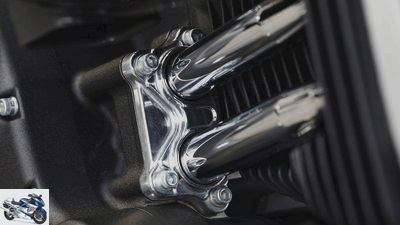
33/35
Harley-Davidson Sportster 883 Iron.
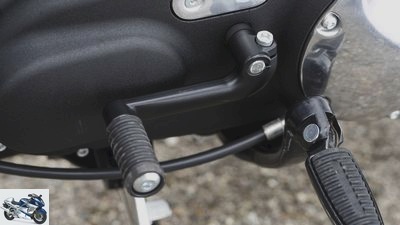
34/35
Harley-Davidson Sportster 883 Iron.
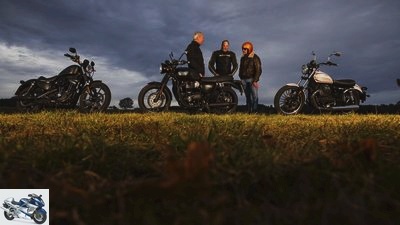
35/35
Photo gallery: Triumph Bonneville T100 Black, Moto Guzzi V9 Roamer and Harley-Davidson Sportster 883 Iron in comparison test.
Triumph Bonneville, Moto Guzzi V9 Roamer and Harley Sportster 883 Iron
Retro roadster in comparison test
In the case of two motorcycles in this test, their manufacturers missed opportunities to improve a number of details without great effort. One took almost every chance. Retro cruiser Triumph Bonneville T 100 Black, Moto Guzzi V9 Roamer and Harley-Davidson Sportster 883 Iron in the test.
triumph B.onneville T100 Black
Buy complete article
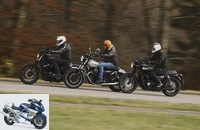
Triumph Bonneville, Moto Guzzi V9 Roamer and Harley Sportster 883 Iron
Retro roadster in comparison test
Sportster 883 Iron:
In 1957 the first Harley-Davidson Sportster came on the market, with four camshafts below, already with 883 cc, but still with cast-iron cylinders and cylinder heads. Our 883 no longer has this despite the additional designation “Iron”. Compared to the Big Twins, the Sportsters were and are light, sporty motorcycles. However, the sportiness of their engines is only really expressed today in the heavily modified versions for flat-track races.
Moto Guzzi V9 Roamer:
The Moto Guzzi V9 Roamer goes back in a direct line to the V 50 C from 1982. Even then, this Italo chopper had little in mind with sportiness, but the drive and frame are at least derived from the small Guzzi athletes V 35 and V 50, which debuted in 1977. As far as the shapes of the tank and seat are concerned, the similarity between the V9 Roamer and the V 50 C is not very pronounced, as there are more connections to Craig Vetter’s Triumph Hurricane from 1973. However, the engine and chassis of the current Guzzi have basically been around since remained the same in the late 1970s.
Like a pack of wolves under a full moon
What the notoriously inefficient engines of the V 50 series couldn’t manage in their time, the current 853 of the Moto Guzzi V9 Roamer achieves: It is the most powerful and liveliest engine in the test field, even exceeds the factory specification by three hp and delivers the best performance of the Trios. The measured values correspond to the felt characteristics. The V9-V2 lags behind the Harley-Davidson Sportster 883 Iron and especially the Triumph Bonneville T 100 Black in terms of torque up to around 5,300 rpm, but when the other two are tired again, it happily storms off to its peak in performance. Up there, just before the rev limiter, it runs in a somewhat cultivated manner, while otherwise it vibrates vigorously over the entire rev range when it is running under load. It feels like he’s slamming against the underside of the seat just below the driver’s butt, and it tarnishes the joy of his robust temperament.
The drivetrain of the Moto Guzzi V9 Roamer gives cause for amazement, if not concern. In the top three gears in particular, the six-speed gearbox and cardan drive, newly designed for 2015, howl like a pack of wolves under a full moon. Every shift, every load change is accompanied by a powerfully voiced “clone” that even attracts the attention of passers-by in city traffic. No question about it, a Moto Guzzi can and should display rustic manners, but in the case of the test copy, the tolerances in the assembly of the engine, gearbox and rear-wheel drive are probably a bit too far on the rough side.
Triumph Bonneville T 100 runs extremely cultivated
The Triumph Bonneville T 100 Black demonstrates how it can be done completely differently. With an ignition offset of 270 degrees and a balance shaft, the water-cooled in-line two-cylinder runs extremely cultivated without looking boringly smooth. The driver can still feel the engine pulsing, especially when using the early torque maximum to push up an incline, lazy to change gear. The gear changes are precise, easy and with short shift travel, the load changes smoothly. The two exhausts sound subtle, dark like their coating, but by no means powerless. The T 100 has the gift of taking you away from the hustle and bustle in the shortest possible distance. It doesn’t do anything that would disturb the driver’s wellbeing or tear him out of the flow of a rhythmic sequence of bends.
Harley Sportster 883 vibrates like Guzzi V9
The Harley-Davidson Sportster 883 Iron vibrates at least as strongly as the Moto Guzzi V9 Roamer, but thanks to the rubber mounts of the engine, the driver only receives the pleasant portion of it. It is the opposite with the engine sound; You drive away from the powerful, externally audible bass, and only the tinny part of the sound spectrum is kept to yourself. In terms of performance, you shouldn‘t drive the 883 like the 1200 Sportster or even the Big Twins. The small Sportster requires higher speeds; the strong pulling force in the lower area, which the noticeably heavy flywheel suggests, does not like to adjust uphill. The 45-degree V2 only pounds listlessly and self-destructively on its crank mechanism.
However, if you save yourself the one or other noisy gear change and drive the engine speed above 4,000 rpm, you will spark a surprising revving pleasure. Then the typical “potato, potato” beat gives way to an enthusiastic roar, and you think you’ve found the right way to handle the engine. Unfortunately this touch of temperament is already prevented in the rising part of the performance curve; the limiter kicks in at less than 6,000 rpm. Couldn’t higher speeds be released there? The Harley-Davidson Sportster 883 Iron, with which the German Harley Cup was held many years ago on real, permanent racetracks, turned higher without any difficulties. Or maybe the designers shouldn’t lock up a heavy long-stroke crankshaft in lifting spaces of less than 1200 cm³.
Sitting position on the Moto Guzzi V9 Roamer
The Moto Guzzi V9 Roamer test machine is already homologated according to Euro 4, but still comes from the 2016 model year. MOTORRAD only received it for this comparison on the condition that they refer to the revised 2017 model. The position of the footrests was changed – they moved ten centimeters backwards and 3.5 upwards – as well as the bench. The seating position is now 15 millimeters lower.
How these changes go together remains to be seen, but the ergonomics on the Moto Guzzi V9 Roamer we tested cannot convince. You don’t have to be too long to bump your knee because of the notches on the left cylinder, and you don’t have to be a stubborn super sports fan to find the sitting position too passive. This impression is exacerbated by the large front wheel and the soft springs on the rear stereo struts. If even a rider weighing 75 kilograms is seated, the rear sags by more than half of the compression travel.
Apart from the ergonomic and geometry of the chassis, all that remains to work through any bumps in the road is the hardness, which follows the very soft, and the elasticity of the tire. The fork of the Moto Guzzi V9 Roamer has greater suspension reserves, but responds poorly despite the low hydraulic damping. Suspension comfort, as you would like it to be for relaxed gliding, may not come about.
Sitting position on the Harley-Davidson Sportster 883 Iron
In this discipline, the Harley-Davidson Sportster 883 Iron is no better, with the insignificant difference that its shock absorbers save the detour of a too soft set-up. They are simply hard-sprung, completely overdamped in the rebound stage and have an extremely short travel to work. The figure of 41 millimeters is probably based on confusing the damper stroke with the actual spring deflection, which is longer thanks to the inclination of the suspension struts. The difference does not have any effect in driving practice. As on the Guzzi, it hits the back, especially since the Harley places its rider with the buttocks far back and the feet far in front. This leaves them with little opportunity to mitigate the shocks by supporting them in the footrests.
Sitting position on the Triumph Bonneville T 100 Black
If the Triumph were compared to a motorcycle that is equipped with high-end suspension elements, it would certainly leave a lot to be desired. Therefore it does not get too many points in the relevant ratings. Of course, it is vastly superior to the comparison test competitors Moto Guzzi V9 Roamer and Harley-Davidson Sportster 883 Iron. One would think that it combines the characteristics of a super athlete and a touring litter, simply because it has reasonably responsive, sensibly coordinated spring elements with a travel of 120 millimeters each. There is no doubt: this motorcycle, equipped with the greatest possible simplicity, has been carefully developed. If you want a bit more active driving, you could perhaps turn the handlebars a bit forwards or mount a bar with a lower offset. You don’t want to change anything more about it, at least not for reasons of functionality. For more extensive requests, Triumph offers a whole range of other retro classics.
Handling the retro roadster
When driving the Triumph Bonneville T 100 Black, due to the balanced suspension setup and the homogeneous steering properties, it is easy to forget that it doesn’t turn in easily. It takes a little stronger steering impulses to initiate a curve, but once it has rested to lean into the curve, it only offers just enough resistance to even deeper lean angles not to appear wobbly.
This is where it differs fundamentally from the Moto Guzzi V9 Roamer, which can be folded down very easily from the neutral position, but then has to be forced to actually remain in an inclined position until the end of the curve with energetic steering effort. The flattest steering head in the comparison as well as the longest caster and wheelbase work together to create a powerful righting moment.
One phenomenon is the Harley-Davidson Sportster 883 Iron’s love of curves. Although it would have to act slowly in changes of direction according to all the chassis parameters, the already mentioned passive seating position and its weight, it can be steered quite quickly and precisely. If you have properly calibrated your body’s lean angle sensor and learned to balance along the scratch line of footrests and exhaust, you can drive it at an astonishingly brisk basic speed over winding country roads. Because of the tight lean angle, you should always choose the soft “rain line” that is drawn in a rather wide arc.
Moto Guzzi V9 Roamer with the best braking performance
This driving style also goes well with the Harley-Davidson Sportster 883 Iron because it was not made for sharp, precise braking into corners. Admittedly, such maneuvers are rarely required by retro roadsters, but you can even teach a single disc brake a little more bite with significantly less hand strength, and that would also look good on a Harley. Especially in times of compulsory ABS, which prevents the front wheel from locking when the brakes are braked. Until that is done, Harley riders must always be ready to pull the lever hard at the front and brake hard at the back.
Already noticeably better than the Harley-Davidson Sportster 883, but not nearly as well as the Moto Guzzi V9 Roamer brakes the Triumph Bonneville T 100 Black. At least the hydraulics are set up correctly; the lever can be driven to the blocking limit with acceptable pulling forces. The friction pairing of disc and linings is still a bit too blunt, which also affects the controllability. At least this fact can be remedied relatively easily with sharper accessory coverings.
As indicated above, the Moto Guzzi V9 Roamer serves as a model for this evaluation. With the largest disc diameter and the proven, conventionally bolted four-piston fixed caliper from Brembo, it offers an energetic, finely adjustable brake. It also provides proof that theoretical advantages can actually have beneficial effects in practice
On the other hand, the qualities of the brakes and the dynamics of the engine show that the V9 Roamer has not yet found its center. The plush chassis does not match the sporty character of these assemblies any more than the ergonomics, which are designed in the direction of cruisers. In any case, the Guzzi model range has become increasingly “Americanized” over the past few years. When the Euro 3 models Griso and Stelvio are sold out, only the V7 variants will remain in the range as machines with a European character. And now be careful, the following two sentences are subjective comments: With this model policy, Moto Guzzi is stepping on very thin ice. After all, you’re not Harley-Davidson and you’re still manufacturing in Mandello del Lario, not Milwaukee.
So the Moto Guzzi V9 Roamer is to be hoped that the developers sharpen their character, whether in one direction (cruiser) or the other (naked bike). The Harley and the Triumph show it naturally. Regardless of their respective strengths and weaknesses, both convincingly represent the motorcycle culture from which they come. And it doesn’t bother in the least that the Triumph is produced in Thailand.
Quality of workmanship of the retro bikes
The remark should not be understood as British bashing, but it does appear that the build quality of the Triumph Bonneville T 100 has even benefited from the relocation of production to the Far East. The surfaces of the frame, engine and paintwork are flawless, the electrical system is neat and discreet. High-quality screws, few but flawless chrome parts and carefully polished decorative cooling fins shine from the black and matt black surroundings. The only thing you can look at with raised eyebrows on the T 100 are the mufflers, which are a little cross-eyed or, in the case of the right muffler, sit a tad too loosely in their rubber mounts. Like most exhausts with a matt black coating, they should be cleaned more often, preferably with a rag soaked in spray oil, and especially where you can’t look.
This also applies to the exhausts of the Harley-Davidson Sportster 883 Iron, which require a little more time to clean thoroughly, as they have black covers under which the dirt can collect. Overall, the Harley is less carefully crafted than the Triumph; the rear-view mirrors interfere with reaching for the levers, the area around the steering head and under the small bean-shaped tank shows a hodgepodge of cables, wires, cable ties and plastic covers, which opposes the simple elegance it strives for.
The style of the Moto Guzzi V9 Roamer also arouses conflicting feelings. Pretty and practical details like the chrome-plated exhaust system, the conical aluminum washers or cranked valves can be found next to an almost painfully sober installation of electrical components and brake lines. The handlebar clamp is then finally no longer a matter of taste. When maneuvering before the test drives, the chrome handlebars simply folded forward. It was good that until then nobody had to lean on it when braking. The flat surfaces of the clamping blocks are so thickly painted that they touch and do not hold the handlebars securely. Reworking here is not the job of a customer who pays almost 10,000 euros for the motorcycle.
To use this as an opportunity to make a conclusion before the conclusions: In the case of two motorcycles in this comparison, their manufacturers have missed opportunities to improve them in a number of details without great effort, for example with different struts. One took almost every chance.
Conclusion from the test
1. Triumph Bonneville T 100 Black: As the table of points shows (in PDF for download or in issue 2/2017), this test is a clear one. The Bonneville T 100 wins four out of five rating chapters, some with a huge lead. It’s a rested, balanced, well-made motorcycle.
2. Moto Guzzi V9 Roamer: Engine and brakes good, smoothness and chassis less. Apart from its strengths and weaknesses in detail, the Moto Guzzi also suffers from being neither a naked bike nor a cruiser and also not showing a convincing middle ground.
3. Harley-Davidson Sportster 883 Iron: More speed. Or more displacement and therefore higher torque. Longer suspension travel, more lean angle, better brakes. This is what the testers want for the 883. Since it cannot offer all of this, it loses this comparison.
Related articles
-
Moto Guzzi V9 Roamer, Triumph Street Scrambler and Yamaha SCR 950 in comparison test
Jahn 30 pictures markus-jahn.com 1/30 Triumph Street Scrambler, Moto Guzzi V9 Roamer and Yamaha SCR 950 in the comparison test. markus-jahn.com 2/30 Moto Guzzi …
-
Harley-Davidson Sportster 883 Iron and Yamaha XV 950 in the test
Gargolov 34 photos Gargolov 1/34 Both cruisers aim high. Which bike is more convincing?? Gargolov 2/34 The point for the feel-good effect clearly goes to…
-
Rossen Gargolov 33 pictures r-photography.info 1/33 Harley-Davidson Sportster 1200 Custom, Moto Guzzi V9 Bobber and Triumph Bonneville Bobber – Cruiser for …
-
Harley-Davidson Sportster Iron 883 and Harley-Davidson Street 750 in comparison test
www. 25th photos www. 1/25 Harley-Davidson wants to expand its fan base, the Harley-Davidson Street 750 is intended to inspire…
-
Harley-Davidson Road King Classic against Moto Guzzi California 1400 Touring in the test
fact 50 photos fact 1/50 Moto Guzzi California 1400 Touring fact 2/50 Harley-Davidson Road King Classic versus Moto Guzzi California 1400 Touring in…
-
BMW R nineT, Moto Guzzi V9 Roamer, Triumph Thruxton and Yamaha XSR 900
17 pictures 1/17 Modern Classics at the Alpen Masters 2016: BMW R nineT, Moto Guzzi V9 Roamer, Triumph Thruxton and Yamaha XSR 900 ….
-
Comparison test of show bikes: Bimota Mantra, Moto Guzzi Centauro and Triumph Speed Triple
Comparison test show bikes: Bimota Mantra, Moto Guzzi Centauro and Triumph Speed Triple The onlookers Don’t be too humble. Why …
-
Ducati Scrambler Classic, Moto Guzzi V7 II Scrambler and Triumph Scrambler in comparison test
34 pictures 1/34 The predecessors of Enduros at the time, the current Scramblers are at first glance little more than …
-
Gargolov comparative test cruiser: BMW R 1200 C Montauk, Harley-Davidson Sportster 1200 Custom, Triumph Speedmaster The way to happiness It doesn’t always have to …
-
BMW R nineT Pure and Triumph Bonneville T120 Black
markus-jahn.com 29 pictures markus-jahn.com 1/29 BMW R nineT Pure and Triumph Bonneville T120 Black in comparison test. markus-jahn.com 2/29 Impressions …